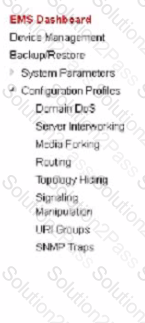71301X Avaya Aura Communication Applications Implement Certified Exam Free Practice Exam Questions (2025 Updated)
Prepare effectively for your Avaya 71301X Avaya Aura Communication Applications Implement Certified Exam certification with our extensive collection of free, high-quality practice questions. Each question is designed to mirror the actual exam format and objectives, complete with comprehensive answers and detailed explanations. Our materials are regularly updated for 2025, ensuring you have the most current resources to build confidence and succeed on your first attempt.
Which two configuration steps must be performed on the Avaya Aura® Communication Manager (CM) for integrating it with the Application Enablement Services (AES), and enabling the TSAPI link? (Choose two.)
When in System Manager (SMGR), which statement about enabling IM and Presence for an Avaya Aura® user is true?
When deploying a Survivable Communication Manager (CM), which statement about the Server ID value is true?
Which event triggers a Survivable Communication Manager (CM) to accept IP phones registration requests, and put the configured IP trunks in a working condition?
Which two statements about the Avaya Session Border Controller for Enterprise (ASBCE) certificate management are true? (Choose two.)
To allow communications between the Avaya Aura® Device Services (AADS) and the Avaya Aura® Web Gateway (AAWG), which three configuration steps are required? (Choose three.)
If the customer requires High Availability (HA) for the Avaya Session Border Controller for Enterprise (ASBCE), what is the minimum number of servers / virtual machines that are required?
In the context of Avaya Aura® Presence Services, what is a Watcher?
You are deploying the Avaya Aura® Presence Services on Avaya Breeze®.
When looking under Elements > Avaya Breeze> Service Management > Services in Avaya Aura® System Manager, which status would you expect to see for a Presence Services snap-in that is ready to support Presence and IM?
Which statement describes how an H.248 signaling link connects the Internet Friendly (Edge) Gateway to the Avaya Communication Manager (CM)?
A user has been informed by the Attendant that a call for them has been parked using the Avaya Call Park and Page running on the Breeze® platform. How can the user retrieve the parked call?
Before running the initTM -f command from the Avaya Breeze® server CLI, what should be verified?
After running the Install wizard on the Avaya Session Border Controller for Enterprise (ASBCE), you add a Public (External) IP address to the Bl interface. You try to ping this IP address from a PC in the same subnet, but it fails.
What is the first step to resolve the problem?
The customer plans to have 50 SIP Trunks and 100 Remote Workers supported by the Avaya Session Border Controller for Enterprise (ASBCE). How many ASBCE licenses will they require?
Refer to the exhibit.

Which type of a Configuration Profile in the Avaya Session Border Controller for Enterprise (ASBCE) allows to set Timers, URI Manipulation and Header Manipulation, and can be linked to a SIP Server Profile?
Which statement about the Avaya Aura® Presence Services snap-in licensing is true?
Refer to the exhibit.

With Dynamic Licensing configured in the Avaya Session Border Controller for Enterprise (ASBCE), when will the ASBCE issue a request to the WebLM server to allocate additional licenses based on "Fetch Count" value?
To provide the customized music, prompts, and/or error announcements when using the Avaya Call Park and Page, which Avaya application server is used?
Which statement about SIP Entities being required to support Avaya Aura® Presence Services hosted on a single Avaya Breeze® server is true?
A customer reports that while using Avaya Aura® Presence Services, the users cannot see the Presence status. Which CLI tool is used to trace PUBLISH messages in the Avaya Breeze® server?
